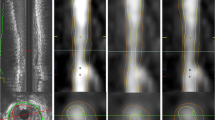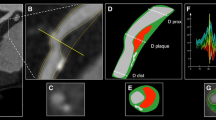Abstract
Objectives
Compared with X-ray coronary angiography (CAG), magnetic resonance imaging of the coronary vessel wall (MR-CVW) may provide more information about plaque burden and coronary remodelling. We compared MR-CVW with intravascular ultrasound (IVUS), the standard of reference for coronary vessel wall imaging, with regard to plaque detection and wall thickness measurements.
Methods
In this study 17 patients with chest pain, who had been referred for CAG, were included. Patients underwent IVUS and MR-CVW imaging of the right coronary artery (RCA). Subsequently, the coronary vessel wall was analysed for the presence and location of coronary plaques.
Results
Fifty-two matching RCA regions of interest were available for comparison. There was good agreement between IVUS and MR-CVW for qualitative assessment of presence of disease, with a sensitivity of 94% and specificity of 76%. Wall thickness measurements demonstrated a significant difference between mean wall thickness on IVUS and MR-CVW (0.48 vs 1.24 mm, P < 0.001), but great heterogeneity between wall thickness measurements, resulting in a low correlation between IVUS and MR-CVW.
Conclusions
MR-CVW has high sensitivity for the detection of coronary vessel wall thickening in the RCA compared with IVUS. However, the use of MRI for accurate absolute wall thickness measurements is not supported when a longitudinal acquisition orientation is used.
Key Points
• Both MRI and IVUS can assess coronary vessels
• Both MRI and IVUS can identify coronary vessel wall thickening.
• MRI provides more information about the coronary plaque burden than conventional angiography.
• However, MRI overestimates absolute coronary wall thickness when compared with IVUS.





Similar content being viewed by others
Abbreviations
- AUC:
-
Area under the curve
- BSSFP:
-
Balanced steady state free precession
- CAD:
-
Coronary artery disease
- CAG:
-
X-ray coronary angiography
- CMRA:
-
Coronary MR angiography
- CT:
-
Computed tomography
- DIR:
-
Double inversion recovery
- FFR:
-
Fractional flow reserve
- FWHM:
-
Full width at half maximum
- IVUS:
-
Intravascular ultrasound
- MESA:
-
Multi-Ethnic Study of Atherosclerosis
- MRI:
-
Magnetic resonance imaging
- MR-CVW:
-
Magnetic resonance coronary vessel wall imaging
- NPV:
-
Negative predictive value
- PCI:
-
Percutaneous coronary intervention
- PPV:
-
Positive predictive value
- PROCAM:
-
Prospective Cardiovascular Münster Heart Study
- RCA:
-
Right coronary artery
- ROC:
-
Receiver operating characteristic curve
- ROI:
-
Region of interest
- SPIR:
-
Spectral presaturation with inversion recovery
References
Glagov S, Weisenberg E, Zarins CK, Stankunavicius R, Kolettis GJ (1987) Compensatory enlargement of human atherosclerotic coronary arteries. N Engl J Med 316:1371–1375
Libby P (2002) Inflammation in atherosclerosis. Nature 420:868–874
Schoenhagen P, Ziada KM, Kapadia SR, Crowe TD, Nissen SE, Tuzcu EM (2000) Extent and direction of arterial remodeling in stable versus unstable coronary syndromes: an intravascular ultrasound study. Circulation 101:598–603
Losordo DW, Rosenfield K, Kaufman J, Pieczek A, Isner JM (1994) Focal compensatory enlargement of human arteries in response to progressive atherosclerosis. In vivo documentation using intravascular ultrasound. Circulation 89:2570–2577
Fayad ZA, Nahar T, Fallon JT et al (2000) In vivo magnetic resonance evaluation of atherosclerotic plaques in the human thoracic aorta: a comparison with transesophageal echocardiography. Circulation 101:2503–2509
Yuan C, Beach KW, Smith LH Jr, Hatsukami TS (1998) Measurement of atherosclerotic carotid plaque size in vivo using high resolution magnetic resonance imaging. Circulation 98:2666–2671
Corti R, Fuster V, Fayad ZA et al (2002) Lipid lowering by simvastatin induces regression of human atherosclerotic lesions: two years’ follow-up by high-resolution noninvasive magnetic resonance imaging. Circulation 106:2884–2887
Adams GJ, Greene J, Vick GW 3rd et al (2004) Tracking regression and progression of atherosclerosis in human carotid arteries using high-resolution magnetic resonance imaging. Magn Reson Imaging 22:1249–1258
Botnar RM, Stuber M, Kissinger KV, Kim WY, Spuentrup E, Manning WJ (2000) Noninvasive coronary vessel wall and plaque imaging with magnetic resonance imaging. Circulation 102:2582–2587
Kim WY, Stuber M, Bornert P, Kissinger KV, Manning WJ, Botnar RM (2002) Three-dimensional black-blood cardiac magnetic resonance coronary vessel wall imaging detects positive arterial remodeling in patients with nonsignificant coronary artery disease. Circulation 106:296–299
Botnar RM, Kim WY, Bornert P, Stuber M, Spuentrup E, Manning WJ (2001) 3D coronary vessel wall imaging utilizing a local inversion technique with spiral image acquisition. Magn Reson Med 46:848–854
Austen WG, Edwards JE, Frye RL et al (1975) A reporting system on patients evaluated for coronary artery disease. Report of the Ad Hoc Committee for Grading of Coronary Artery Disease, Council on Cardiovascular Surgery, American Heart Association. Circulation 51:5–40
Dijkstra J, Koning G, Reiber JH (1999) Quantitative measurements in IVUS images. Int J Card Imaging 15:513–522
Adame IM, van der Geest RJ, Wasserman BA, Mohamed MA, Reiber JH, Lelieveldt BP (2004) Automatic segmentation and plaque characterization in atherosclerotic carotid artery MR images. MAGMA 16:227–234
Di Mario C, Gorge G, Peters R et al (1998) Clinical application and image interpretation in intracoronary ultrasound. Study Group on Intracoronary Imaging of the Working Group of Coronary Circulation and of the Subgroup on Intravascular Ultrasound of the Working Group of Echocardiography of the European Society of Cardiology. Eur Heart J 19:207–229
He Y, Zhang Z, Dai Q et al (2012) Accuracy of MRI to identify the coronary artery plaque: a comparative study with intravascular ultrasound. J Magn Reson Imaging 35:72–78
Miao C, Chen S, Macedo R et al (2009) Positive remodeling of the coronary arteries detected by magnetic resonance imaging in an asymptomatic population: MESA (Multi-Ethnic Study of Atherosclerosis). J Am Coll Cardiol 53:1708–1715
Toussaint JF, LaMuraglia GM, Southern JF, Fuster V, Kantor HL (1996) Magnetic resonance images lipid, fibrous, calcified, hemorrhagic, and thrombotic components of human atherosclerosis in vivo. Circulation 94:932–938
Leiner T, Gerretsen S, Botnar R et al (2005) Magnetic resonance imaging of atherosclerosis. Eur Radiol 15:1087–1099
Stolzmann P, Scheffel H, Leschka S et al (2008) Influence of calcifications on diagnostic accuracy of coronary CT angiography using prospective ECG triggering. AJR Am J Roentgenol 191:1684–1689
Ong TK, Chin SP, Liew CK et al (2006) Accuracy of 64-row multidetector computed tomography in detecting coronary artery disease in 134 symptomatic patients: influence of calcification. Am Heart J 151:1323.e1–1323.e6
Nakatani S, Yamagishi M, Tamai J et al (1995) Assessment of coronary artery distensibility by intravascular ultrasound. Application of simultaneous measurements of luminal area and pressure. Circulation 91:2904–2910
Decramer I, Vanhoenacker PK, Sarno G et al (2008) Effects of sublingual nitroglycerin on coronary lumen diameter and number of visualized septal branches on 64-MDCT angiography. AJR Am J Roentgenol 190:219–225
Yamagishi M, Nissen SE, Booth DC et al (1995) Coronary reactivity to nitroglycerin: intravascular ultrasound evidence for the importance of plaque distribution. J Am Coll Cardiol 25:224–230
Acknowledgements
The authors would like to thank Boston Scientific Benelux B.V. for their training in and assistance with acquiring the IVUS-images. Furthermore, we would like to thank all interventional cardiologists working in the Maastricht University Medical Centre, for their assistance with IVUS procedures.
This study was supported by BayerSchering Pharma. The sponsor had no influence on study design, data collection or analysis of the data.
Trial registration:www.clinicaltrials.gov ID: NCT00984776
Author information
Authors and Affiliations
Corresponding author
Rights and permissions
About this article
Cite this article
Gerretsen, S., Kessels, A.G., Nelemans, P.J. et al. Detection of coronary plaques using MR coronary vessel wall imaging: validation of findings with intravascular ultrasound. Eur Radiol 23, 115–124 (2013). https://doi.org/10.1007/s00330-012-2576-1
Received:
Revised:
Accepted:
Published:
Issue Date:
DOI: https://doi.org/10.1007/s00330-012-2576-1




